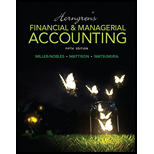
1.a
Bonds: Bonds are long-term promissory notes that are represented by a company while borrowing money from investors to raise fund for financing the operations.
Bonds Payable: Bonds payable are referred to long-term debts of the business, issued to various lenders known as bondholders, generally in multiples of $1,000 per bond, to raise fund for financing the operations.
To identify: The types of
b.
Bonds: Bonds are long-term promissory notes that are represented by a company while borrowing money from investors to raise fund for financing the operations.
Bonds Payable: Bonds payable are referred to long-term debts of the business, issued to various lenders known as bondholders, generally in multiples of $1,000 per bond, to raise fund for financing the operations.
To identify: The types of bond price.
c.
Bonds: Bonds are long-term promissory notes that are represented by a company while borrowing money from investors to raise fund for financing the operations.
Bonds Payable: Bonds payable are referred to long-term debts of the business, issued to various lenders known as bondholders, generally in multiples of $1,000 per bond, to raise fund for financing the operations.
To identify: The types of bond price.
2.
Bonds: Bonds are long-term promissory notes that are represented by a company while borrowing money from investors to raise fund for financing the operations.
Bonds Payable: Bonds payable are referred to long-term debts of the business, issued to various lenders known as bondholders, generally in multiples of $1,000 per bond, to raise fund for financing the operations.
To compute: Price of bonds
3.
To calculate: The amount of interest paid each year.
To calculate: Interest expense for the first year.
Want to see the full answer?
Check out a sample textbook solution
Chapter 12 Solutions
Horngren's Financial & Managerial Accounting Plus Mylab Accounting With Pearson Etext -- Access Card Package (5th Edition) (miller-nobles Et Al., The Horngren Accounting Series)
- Provide answer general accountingarrow_forwardFinancial Accounting MCQarrow_forwardABC is an all-equity firm that has 44,200 shares of stock outstanding at a market price of $14.70 per share. The firm is considering a capital structure with 53% debt at a rate of 5% and use the proceeds to repurchase shares. Determine the shares outstanding once the debt is issued. Need help financial Accountingarrow_forward
- Accounting sum 6 ptsarrow_forwardABC is an all-equity firm that has 44,200 shares of stock outstanding at a market price of $14.70 per share. The firm is considering a capital structure with 53% debt at a rate of 5% and use the proceeds to repurchase shares. Determine the shares outstanding once the debt is issued.arrow_forwardMCQarrow_forward
 Cornerstones of Financial AccountingAccountingISBN:9781337690881Author:Jay Rich, Jeff JonesPublisher:Cengage LearningPrinciples of Accounting Volume 1AccountingISBN:9781947172685Author:OpenStaxPublisher:OpenStax College
Cornerstones of Financial AccountingAccountingISBN:9781337690881Author:Jay Rich, Jeff JonesPublisher:Cengage LearningPrinciples of Accounting Volume 1AccountingISBN:9781947172685Author:OpenStaxPublisher:OpenStax College EBK CONTEMPORARY FINANCIAL MANAGEMENTFinanceISBN:9781337514835Author:MOYERPublisher:CENGAGE LEARNING - CONSIGNMENT
EBK CONTEMPORARY FINANCIAL MANAGEMENTFinanceISBN:9781337514835Author:MOYERPublisher:CENGAGE LEARNING - CONSIGNMENT Excel Applications for Accounting PrinciplesAccountingISBN:9781111581565Author:Gaylord N. SmithPublisher:Cengage Learning
Excel Applications for Accounting PrinciplesAccountingISBN:9781111581565Author:Gaylord N. SmithPublisher:Cengage Learning



